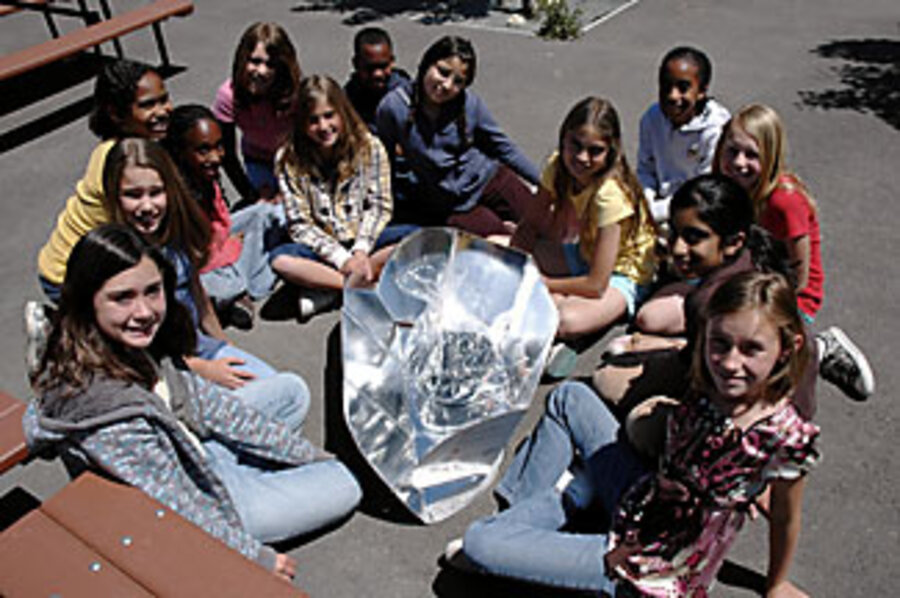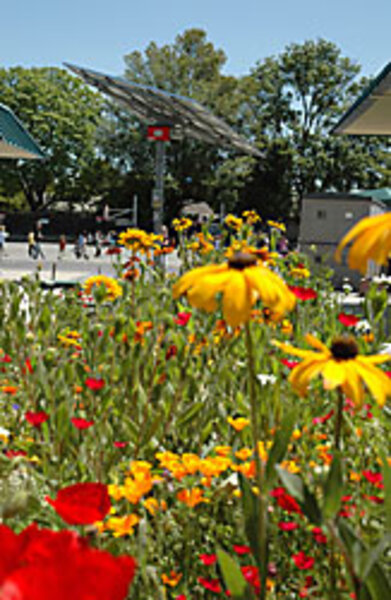For kids: Electricity from the sun
Loading...
| Pleasanton, Calif.
You may have heard a lot lately about solar and other earth-friendly energies. So what's so cool about solar power? Well, for one thing, Earth receives as much energy from the sun in one hour as the world uses in one year!
For thousands of years, humans have taken advantage of the sun's energy for growing crops, drying clothes, sunbathing, and more. Yet it is only relatively recently that people figured out how to harness the sun's rays and transform this free, clean, and renewable energy into electricity.
Journey toward harnessing the sun
About 1861, Auguste Mouchout, a French inventor, made the first solar-powered motor. It was a glass-enclosed iron cauldron. When sunlight passed through the glass, the water heated up and created steam, which powered the engine. Many moving things such as trains used steam-powered engines in those days. But steam normally came from water heated by burning coal. As coal became cheaper in France, the French government decided that although Mouchout's invention worked well, it was too expensive to produce. This was true for many solar inventions that followed.
Albert Einstein won the Nobel Prize in Physics in 1921 for his research on the "photoelectric effect," a phenomenon that helped scientists see how light could be converted into electric current. In 1940, American engineer Russell Ohl discovered that light shining on a cracked crystal caused a small electric current. This led to his creation of the first silicon solar cell, but it produced only a small amount of electricity.
In 1954, scientists Gerald Pearson, Daryl Chapin, and Calvin Fuller developed the first silicon solar cell capable of making a measurable amount of solar power. But compared with coal and oil, making electricity from solar power was just too expensive.
In fact, it wasn't a scientific breakthrough that helped solar to become more readily available, but mass orders of solar photovoltaic cells (PVs) from countries such as Japan and Germany. Their governments started solar rooftop programs (Japan in 1994 and Germany in 2000) to improve environmental protection. After that, people in both countries began demanding more solar panels, which caused the price of PVs to drop. When solar cells are cheaper, more people, organizations, and governments can afford to use them.
Solar schools
Earlier this year, the Pleasanton Unified School District in California became one of the first and largest school districts to "go solar."
This move toward solar energy began in 2004 when Walnut Grove Elementary School in Pleasanton was awarded a grant from a utility company for a 1-kilowatt solar cell. The cell stands high on a pole on the playground and is referred to affectionately as "the PV on a stick."
"Although [the PV] doesn't create that much electricity, it stands as a symbol and generates a lot of interest. It opens discussions, and that creates human energy," says Bill Radulovich, principal at Walnut Grove.
Each spring, the first-grade students at Walnut Grove plant sunflower seeds next to the PV. They measure and record the seedlings as they grow. The sunflower heads follow the sun's movement across the sky mirroring the PV's movements, both chasing sunbeams and converting them into energy.
Since the solar program at Walnut Grove proved successful, discussions opened up between the Pleasanton school district and a few energy companies, including the one involved with the original PV on a stick. Eventually, the companies agreed to pay for the installation of solar panels that are linked to seven school sites. As part of the agreement, the Pleasanton school district gets ecofriendly solar power at fixed low prices for the next 20 years.
Pleasanton schools now produce enough solar energy to power 1,000 classrooms, and solar power meets 20 percent of the district's energy needs.
During summer vacation, when the schools aren't using the solar power, it goes back to the power grid and on to other buildings that need it.
Solar kids
Carol Kato, who teaches science at Walnut Grove, showed me how her students learn hands-on about solar energy. They use special beads to test the effectiveness of their sunblock. (When the white beads are exposed to the sun, they change into bright colors.) The classes also play with a giant solar balloon that rises into the air as it is heated by the sun. Even a dollhouse has solar panels that actually power lights and fans and produce hot water!
Kids at Walnut Grove are also figuring out ways to send solar ovens to some students and their families overseas as part of the Hands Across the Water project. The project was started by Sharon Tangney, the school counselor.
Kids who are involved collect school supplies, books, games, and other items to send to Walnut Grove's sister school in Liberia, a country in West Africa. Solar ovens would provide the Liberian students' families with a sustainable way to cook so they wouldn't have to buy kerosene or cut down trees to burn for cooking fuel.
You may think the Pleasanton school district's solar-energy achievements are all very well in sunny California, but solar power is taking off across the nation, too. Schools are going solar and corporations are lining up to help. The future looks bright for solar power!






